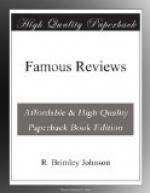The first thing that strikes the reader of Thalaba, is the singular structure of the versification, which is a jumble of all the measures that are known in English poetry (and a few more), without rhyme, and without any sort of regularity in their arrangement. Blank odes have been known in this country about as long as English sapphics and dactylics; and both have been considered, we believe, as a species of monsters, or exotics, that were not very likely to propagate, or thrive, in so unpropitious a climate. Mr. Southey, however, has made a vigorous effort for their naturalisation, and generously endangered his own reputation in their behalf. The melancholy fate of his English sapphics, we believe, is but too generally known; and we can scarcely predict a more favourable issue to the present experiment. Every combination of different measures is apt to perplex and disturb the reader who is not familiar with it; and we are never reconciled to a stanza of a new structure, till we have accustomed our ear to it by two or three repetitions. This is the case, even where we have the assistance of rhyme to direct us in our search after regularity, and where the definite form and appearance of a stanza assures us that regularity is to be found. Where both of these are wanting, it may be imagined that our condition will be still more deplorable; and a compassionate author might even excuse us, if we were unable to distinguish this kind of verse from prose. In reading verse, in general, we are guided to the discovery of its melody, by a sort of preconception of its cadence and compass; without which, it might often fail to be suggested by the mere articulation of the syllables. If there be any one, whose recollection does not furnish him with evidence of this fact, he may put it to the test of experiment, by desiring any of his illiterate acquaintances to read off some of Mr. Southey’s dactylics, or Sir Philip Sidney’s hexameters. It is the same thing with the more unusual measures of the ancient authors. We have




